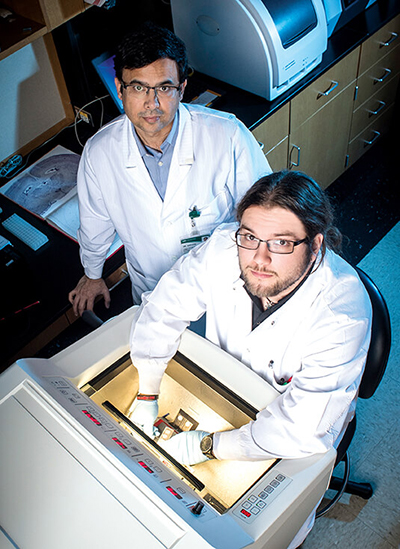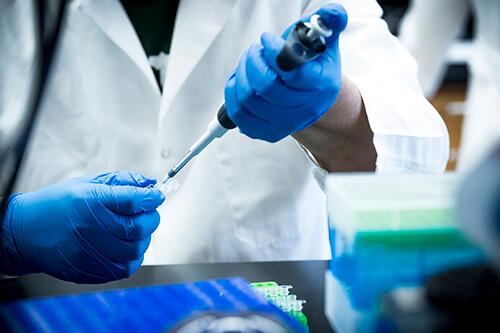 Major
Major
The neuroscience major provides a solid grounding in natural science and a broad familiarity with the field of neuroscience. You will experience small class sizes and have the opportunity to work closely with individual faculty mentors in their research laboratories.
Our program:
- Provides a structure for coursework that assures a solid foundation in natural science and a broad knowledge of the field of neuroscience.
- Satisfies all pre-medical and most pre-health requirements.
- Includes three years of hands-on research in the labs of world-class biomedical researchers.
- Organizes events that communicate current neuroscience research and activity on campus.
- Culminates with the completion and presentation of a comprehensive senior research thesis.
Research
Research is a cornerstone of the Undergraduate Neuroscience Program. Students are given the option to complete either a laboratory-based or literature-based research experience.
-
Laboratory-based Research Experience
Students who elect to complete a laboratory-based research experience are expected to conduct independent research in the labs of primary faculty for no less than three semesters (NBL/PY 398; 6 credit hours total). You will join a lab of your choosing sometime after your freshman year and work one-on-one with researchers to develop and execute an independent research project. Upon conclusion of the research experience, you will write and submit a Research Thesis for approval by your mentor and UNP leadership.
-
Literature-based Research Experience
Students pursuing a literature-based research experience explore experimental design and modern neuroscience techniques using a combination approach in both laboratory and classroom settings. You will begin the literature-based research experience by completing a semester long laboratory course (NBL 390) that utilizes contemporary techniques in neuroscience to illustrate concepts of experimental design and hypothesis testing. The class content and methodology varies by semester and is specific to the research question you are testing.
After completion of the laboratory course, you will embark on an in-depth exploration of current scientific literature (NBL 399). This course aims to develop skills such as critical thinking, analytic reasoning, and scientific writing and presentation. Under the direct supervision of primary faculty, you will formulate and explore a research topic using primary research articles to articulate your point of view. After writing and submitting the research thesis, you will present your work to an audience of your peers and program faculty as a capstone experience in neuroscience.
You can get an idea of what you'll take semester-by-semester by looking at our four-year plans for both options.
 Program Requirements
Program Requirements
To earn a degree in neuroscience, you must complete 67-68 hours of coursework in biology, chemistry, mathematics, physics, psychology, and neuroscience, as well as the UAB Core Curriculum Requirements. All program requirements, courses, and the four-year plans of study are outlined in the UAB Undergraduate Catalog.
FAQs
-
What is Neuroscience?
Neuroscience is the study of the development, structure, and function of the nervous system, with a special focus on the brain and its role in behavior and cognitive functions. Also referred to as neural science, neuroscience seeks to understand not only how the nervous system functions normally, but also what goes wrong in neurodevelopmental, psychiatric, and neurological disorders.
Multidisciplinary in nature, the field of neuroscience spans the structure, function, evolution, development, genetics, biochemistry, physiology, pharmacology, circuitry, and pathology of the nervous system. Therefore, neuroscience integrates biology, chemistry, physics, mathematics, psychology, and computer science. It is one of the most rapidly advancing fields in biomedical research.
In Principles of Neural Science (fourth edition), the noble laureate Dr. Eric Kandel states:
"The task of neural science is to explain behavior in terms of the activities of the brain. How does the brain marshal its millions of individual nerve cells to produce behavior, and how are these cells influenced by the environment...? The last frontier of the biological sciences — their ultimate challenge — is to understand the biological basis of consciousness and the mental processes by which we perceive, act, learn, and remember."
-
What do neuroscientists study?
Many neuroscientists seek to understand the mechanisms that underlie behavior or cognition, where cognition refers to higher mental processes such as thinking, perceiving, imagining, speaking, learning, remembering, problem solving, planning, and acting. This involves understanding how the brain functions at many levels of analysis: from genes to neurons to circuits to behavior.
Neuroscientists also determine how the nervous system develops, matures, and maintains itself throughout its normal lifetime. In addition, neuroscientists seek to identify the mechanisms that underlie:
- neurodevelopmental disorders (such as mental retardation and autism),
- neurological diseases (such as epilepsy and multiple sclerosis),
- neurodegenerative diseases (such as Alzheimer's and Parkinson's disease),
- psychiatric disorders (such as depression and schizophrenia), and
- injury (such as spinal cord injury and stroke).
Understanding the underlying mechanisms is critical for the development of treatments and cures for these devastating disorders and diseases.
-
What do neuroscience majors do after graduation?
We anticipate that most neuroscience majors will continue their training after graduation by matriculating to graduate school, or one of the many professional schools such as medical, veterinary, dental, public health, optometry, nursing, or physical therapy school. Today, there is a high demand for qualified and experienced neuroscience researchers and health-related professionals, and there are many career options:
- Neuroscience researchers and clinicians can teach at medical, dental, pharmacy, nursing or veterinary schools, or hospitals, medical centers, and universities.
- Neurologists, Psychiatrists, Neurosurgeons, Optometrists, and specialized nurses may practice at university affiliated hospitals or enter private practice.
- Other neuroscientists conduct research or lead with administrative positions in government laboratories, private research foundations, and in the pharmaceutical, biotechnology, and chemical industries.
- Neuroscientists also work in government regulatory agencies such as the Food and Drug Administration, the Environmental Protection Agency, Center for Disease Control, or in industrial organizations that work with these agencies.
For students who decide to work directly after graduation, or defer their graduate or professional training, there are entry-level technician positions that can be found in biomedical research laboratories, pharmaceutical or health product companies, and public health programs.
In addition, our students can graduate with a STEM Teaching Certificate through UABTeach. This program allows students to take education classes in addition to the major courses. Upon graduation from UAB students are qualified to teach STEM at the high school level in 30 states.
-
What classes would I take?
Take a look the UAB Undergraduate Catalog for course requirements and descriptions, as well as sample four-year plans for undergraduate neuroscience majors.